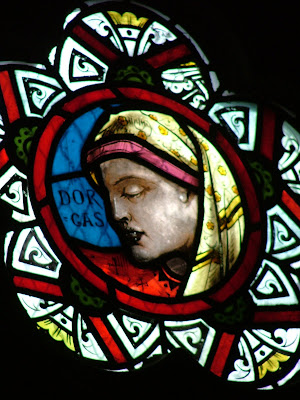I was lucky a few years ago to get into the old Dowanhill Church while it was covered in scaffolding. This allowed some unusual views of the glass that was designed by Daniel Cottier for the architect William Leiper.
Leiper's is a very dramatic building at the crest of a hill above the Clyde looking over to the Cathkin Braes. More about him can be found here.

View from the South
Daniel Cottier was born in Glasgow in January 1837. He apprenticed to a company of glass-stainers in Glasgow and studied under Madox-Brown in London in the early 1860s. In 1862, he went to work in Leith as foreman designer; three years later (1865) he opened his own business in Glasgow. His work on the internal decorations and the glass at Dowanhill was completed only two years later.

Cottier's signature on one of the windows

View from the East
During 1869 he moved to London, opening "Cottier and Co., Art Furniture Makers, Glass and Tile Painters", supplying aesthetic furnishings in the most fashionable styles. In 1873, he opened his New York office and also opened a branch in Australia. He was considered to be an important influence on Louis Comfort Tiffany and also is credited with introducing the aesthetic movement to America and Australia.

Location of the Two Figurative Windows at the Northern End of the East Facade
His work was said to be influenced by the writing of John Ruskin, the paintings of Dante Gabriel Rossetti and the work of William Morris. He painted allegorical figures in the Pre-Raphaelite style and was compared to Rossetti and Sir Edward Burne-Jones. Certainly the female faces here show those influences.

The West Facade

The building is now a theatre and very pleasant bar and restaurant.
During 1869 he moved to London, opening "Cottier and Co., Art Furniture Makers, Glass and Tile Painters", supplying aesthetic furnishings in the most fashionable styles. In 1873, he opened his New York office and also opened a branch in Australia. He was considered to be an important influence on Louis Comfort Tiffany and also is credited with introducing the aesthetic movement to America and Australia.
His work was said to be influenced by the writing of John Ruskin, the paintings of Dante Gabriel Rossetti and the work of William Morris. He painted allegorical figures in the Pre-Raphaelite style and was compared to Rossetti and Sir Edward Burne-Jones. Certainly the female faces here show those influences.
The lower level windows on both the East and West sides of the building are characterised by geometric shapes and stylised plant forms.

This is also carried on to the upper level windows on both sides.

An Upper Level Window on the East side

Detail from East Window Showing the Extent and Detail of the Painting.

 You can see from the images of these windows that the colours were important in the scheme of the windows - as important as the painting.
You can see from the images of these windows that the colours were important in the scheme of the windows - as important as the painting.
It is in the upper range of windows that the figurative element begins to become apparent.

At the top of each window above the two lancets forming each of these windows is a figure.

Mary
Each window has a different colour pattern.


One thing to note about these figures. They are all women. Consider that this was the middle of the 19th century in a Presbyterian church dominated by men. This still seems extraordinary to me.
Another thing that you may have noted already is that all of these women with one or two exceptions have very strong jaws and prominent noses. The influence of the Pre-Raphaelites is strongly felt in the depictions of these women.
The East windows will follow.











No comments:
Post a Comment